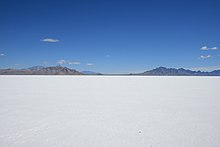Great salt desert
The Great Salt Lake Desert ( English Great Salt Lake Desert ) refers to a region west of the Great Salt Lake in the northern part of the US state of Utah . It was formed towards the end of the last Ice Age as a result of the drying up of Lake Bonneville - a prehistoric lake that stretched over much of the Great Basin west of the Rocky Mountains and of which the Great Salt Lake is the largest remainder.
geography
At the end of the Pleistocene, Lake Bonneville temporarily expanded to around 52,000 km² and was therefore not significantly smaller than today's Lake Michigan at the time . Around 14,000 years ago, a bank structure in the north of the lake broke and in a catastrophic flood event , the so-called Bonneville Flood , large parts of the lake's water masses poured north and flowed over the Columbia River Plateau . As a result, the remaining amount of water began to shrink under the changing climatic conditions; With no major inflow and without any outflow, the lake eventually became too saline.
Today, large parts of the former Bonneville Lake are a salt desert, which extends over an area of around 10,360 km² from the Great Salt Lake in a westerly direction to the state border of Nevada . The desert floor is colored white due to the high salt content.
The only significant place on the edge of the Great Salt Desert is Wendover with around 1500 inhabitants. The area is intersected by Interstate Highway I-80 and a parallel railway line from east to west.
North of the highway in ausgeprägtesten part of the desert is the Bonneville Salt Flats State Park with the Bonneville Speedway -Gelände, often because of its flatness and size for world record attempts and speed records of vehicles is used.
In the north and south of the desert, the United States Army and the United States Air Force maintain a total of four large-scale military training areas . In the Dugway Proving Ground is the Dugway military settlement with around 2000 permanent residents.
Bonneville Salt Flats and the Speed Weeks
In 1896 bicycle races were held on the Bonneville Salt Flats. At the first motor rally in 1914, the racing driver Teddy Tetzlaff accelerated his Blitzen-Benz to 228 km / h. In 1935 Sir Malcolm Campbell set a piston engine record at 484 km / h in his Blue Bird. In 1970 Gary Gabelich drove his Blue Flame rocket car over the salt at over 1000 km / h. The Speed Week has been held annually from the beginning of August to mid-August since 1949 , during which numerous record attempts are made. The date is due to the climate: every year there is about 200 mm of precipitation, which soften the salt. July and August are the driest months.
See also
- After Lake Bonneville was Bonneville Crater on Mars named.
- In 1957 the automobile manufacturer Pontiac named a limited edition passenger car after the Bonneville Flats . This resulted in an upscale series built until 2005 .
literature
- Louise Ann Noeth: Bonneville Salt Flats. MBI Pub. Co., 1999, ISBN 0-7603-0605-2 .
- Louise Ann Noeth: Bonneville: The Fastest Place on Earth. MotorBooks International, 2002, ISBN 0-7603-1372-5 .
Web links
- Great Salt Lake Desert in the United States Geological Survey's Geographic Names Information System
- USGS: Lake Bonneville and the Bonneville Flood
Individual evidence
- ^ Louise Ann Noeth: Bonneville. MBI Publishing Company LLC, 2002, ISBN 0-7603-1372-5 , p. 14. ( limited preview in Google Book search)
- ↑ Nina Rehfeld: There is no salt! In: Financial Times Germany . October 14, 2011, p. 25.
Coordinates: 40 ° 40 ′ N , 113 ° 40 ′ W
